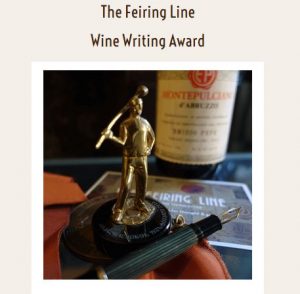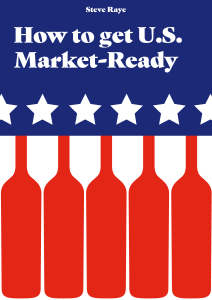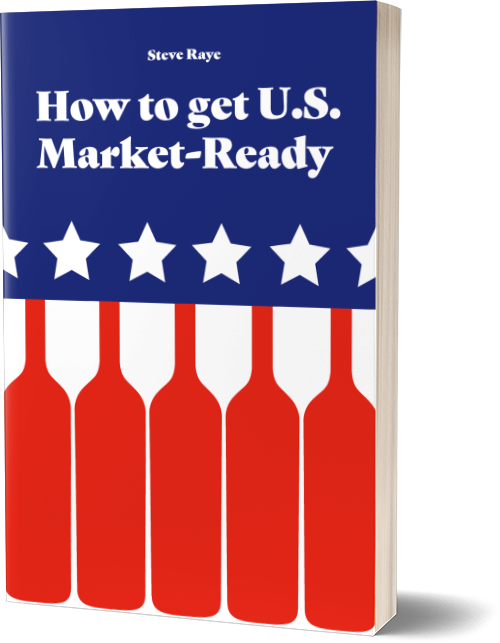Vinitaly International Academy Debuts in Los Angeles
Vinitaly International Academy (VIA) will run a new Italian Wine Ambassador certification course in Los Angeles, California, from February 18th to 22nd, 2019. The new course will be taught by VIA Faculty members Sarah Heller MW and Henry Davar and will feature lectures, guided tastings, tasting labs, in addition to some convivial moments. Applications are now being accepted. Candidate interested in applying should fill out details on the application form.
Course Dates: February 18th to 22nd, 2019
Schedule: 9 AM to 4.30 PM daily (with lunch break)
Places Available:30 candidates
Course Fee:600 Euro
Deadline for Applications:January 18th, 2019
Location: Los Angeles, California
Alice Feiring Sponsors New Wine Writer Competition

The Feiring Line Wine Writing Award
One of my favorite wine writers and a global leader in the natural wine movement, Alice Feiring has started a new competition called the Feiring Line Wine Writing Award.
The competition is teed up for new writers who, as Alice says, “haven’t taken the plunge.”
I’ve made my living in large part from writing about wines and spirits, primarily on the commercial side as a PR and advertising agency copywriter, but also recently in “legit journalism” mode for Meininger’s and other international publications.
And one thing I’ve noticed is that with the explosion of Social Media into and overwhelming the communications mix, the level of professionalism, correct use of grammar and spelling, and ability to make money from the profession have all declined.
So kudos to Alice for taking her own plunge into the contest and awards biz. I highly recommend that anyone who has wanted to write about wine , but found one excuse or another for not doing it, to register for the awards and start writing.
Prof. Clay Shirky pointed out just how important writing is to our evolving national dialog in his seminal book on the subject, “Here Comes Everybody,” (Yes, the book title should have been underlined, not in quotes, but there’s no underline function in the tool I’m using)
“The old dictum that freedom of the press exists only for those who own a press points to the significance of the change. To speak online is to publish, and publish online is to connect with others. With the arrival of globally accessible publishing, freedom of speech is now freedom of the press, and freedom of the press is freedom of assembly”
“Revolution doesn’t happen when society adopts new technologies—it happens when society adopts new behaviors”
And a side note to the students attending my lectures at Bologna Business School and Cornell…this is directed at you.
Food and Wine Insider Podcast Interview of my new book
Check out this link to a new podcast interview of me by Ann Daw of the Food and Wine Insider podcast.
Want to save some time? Head on over to www.GetUSMarketReady.com and register to receive a free chapter. Better yet, go to Amazon.com and order a copy.
“How to Get U.S. Market-Ready” book to be released Nov. 26.
“How to Get U.S. Market-Ready” is my new book that provides practical solutions for export wine and spirit brands looking to enter the American market. The goal of the book is to help new-to-the-U.S. producers avoid making the same mistakes others have made before them, again, for the first time.
The book will be officially published and initially available in pdf form on Nov. 26 concurrent with my presentation at Wine2Wine in Verona. Click here to register for pre-orders.
Readers looking for a successful strategy for approaching the U.S. market should be prepared to let go of preconceived ideas and be open to new ways of thinking. While the American market is known to be challenging, the thesis of this book is that producers need to apply creative thinking, smart data-driven decisions tempered with flexibility to be successful.
Based on my decades of experience in the business you’ll find answers to many of the questions that export producers face:
- What is the best market for me to start with? (Probably not what was your first choice.)
- How do I price my product and what are “normal” margins within the Three-Tier system? (How come everybody else seems to be making more on product than I am?)
- How do I find the right importer? (At least 10 different options, 6 of which you probably never heard of.)
- How can I get a distributor to pay attention to my brand when it represents a small piece of their portfolio? (Competition is fierce, so you must stand out, but how?)
The book contains proprietary tools that I’ve developed to help exporters understand the American market and make the best decisions. These are presented in the text and also will be accessible as excel spreadsheets on the book’s website. Two of the most useful include one on price structure and one on picking the right markets.
Another notable section of the book focuses on changes in the government regulations. The U.S. wine and spirits market is controlled by a crazy mix of archaic regulations. There are several examples of creative, non-traditional solutions that capitalize on the insider knowledge which the author shares.
“How to Get U.S. Market-Ready” is packed with information readers can put to use immediately. It is broken into small sections making it easy to read and digest. And it’s peppered with the author’s hard-won wisdom, compelling anecdotes and passionate advice making it an interesting and fun read.
Bologna Business School MBA has scholarships available
For those of you interested in graduate education in the wine and food business, the Bologna Business School should be a priority to consider. And the really good news is that they still have scholarships available for next academic year. Here’s a link to more information on the program: http://bolognabusinessschool.com/hp/global-mba/mba-food-and-wine/ Oh, and FYI, the class is conducted in English.
And hot news for those who enroll, I’ll be giving a session on the U.S. market at Ludovica Leone’s Wine and Food track at BBS in November.
Podcast Interview from Wine2Wine
When I was in Verona in December to speak at the Wine2Wine conference, I was also did an interview with Monty Waldin for the Italian Wine Podcast series…yet another innovation from Stevie Kim and her team at Vinitaly/Veronafiere that in fact just celebrated its one year anniversary
It was particularly interesting for me to listen to the interview from the perspective what has happened in the three months since it was recorded. Most notably we’ve seen Amazon move Whole Foods buying from a regional to a national function. That’s been accompanied by a whole lot of conversation, frustration and innovation on the ecommerce side of the business along with the questions and opportunities raised by the new excise tax law reduction.
Net net conclusion? I’d like to hear yours! Please listen to the podcast and let me know what you think.
Here’s a direct link to the podcast of my interview, and I highly recommend you sign up to access the series (via SoundCloud app on ITunes or Google Play.) The program includes interviews with a bunch of industry luminaries including Alison Napjus of Wine Spectator, Adam Teeter of VinePair.
Also, FYI, I won’t be at ProWein this year, but I will be attending Vinexpo. Please reach out to me if you would like to set up an appointment to chat there.
Cin Cin.
Steve
Don’t Make Prospects Come to you; Go Where They are Already Gathered
There’s been explosion in wine and spirits websites that fall under the title of Social Media. We’ve found it helpful to segment the category into five distinct components, so we can do a better job of identifying and leveraging the right tools to accomplish different objectives.
It all falls under one guiding strategy: instead of getting a “target audience” to come to you, go where they’re already gathered and their behavior defines their interest.
1. Platforms: Facebook, Twitter, Instagram et al. Defined as places people proactively post and engage (share, comment) with others on a platform that is socially-focused, rather than subject-focused.
2. Tools: Wine-Searcher, Delectable, Cellar Tracker et al. Functionality-driven sites that specialize in a particular subject or service. In most cases these sites are expanding beyond their initial focus to include label recognition technology, consolidated ratings, reviews and awards from both wine critics as well as site users along with the opportunity to share and engage with fellow visitors and across platforms.
3. Sites: Vivino, Vinepair, Liquor.com et al. Destination sites where people with a specific shared interest can access information about a given subject category. Generally, these tend to attract newbies to the wine and spirit category and lean toward education and sharing information rather than providing a single utility. Many, notably Vivino, have expanded to include options for consumers to purchase, recognition that the real money is in sales.
4. Apps: Minibar Delivery, Drizly, Drync, City Hive et al. Purpose-built to provide a service to an audience interested in delivery-within-an-hour, local retail sales leveraging the collective broad inventory of stores in a given geography.
5. E-commerce: Certainly, a category that’s going through tumultuous change in the U.S., but also one with some emerging subgroups. A lot of the activity is driven by accessibility of smaller, craft and hard-to-find brands taking advantage of the “virtual inventory” concept of web-enabled tools.
- Specialty retail ecomm: Restricted interstate to 12 states but permitted intrastate in many more.
- DTC: Direct to consumer sales, currently an option only open to domestic wineries and to a limited degree, distilleries.
- Delivery-within-an-hour from Minibar Delivery, Thirstie, Saucey et al.
- Ecomm ordered/home delivery from grocery: Amazon’s recent purchase of Whole Foods and integration into Prime Now is already starting to make waves.
According to a recent Rabobank report, 2017’s wine and spirits U.S. E-commerce in total generated $1.7B in sales. Specialty retailers account for the lion’s share—today—$975MM, while DTC generated $410MM; Delivery-within-an-hour accounted for $103MM; and E-comm order/delivery from grocery $87MM. (Vivino’s recent VC funding was based on projected sales of $1B by 2020.)
The industry consensus is that interstate restrictions on e-commerce by Specialty Retail will remain challenging as states enact new laws to deal with the recent common carrier clampdown. That said, Amazon’s Purchase of Whole Foods is expected to have a seismic impact on the entire category and quickly dwarf Specialty Retail’s dominance.
One other change of note is that the new Excise Tax Law for the first time includes imported brands. We think that’s the first “chink in the armor” of regulation towards allowing imported brands to participate in DTC. Stay tuned for news on that.
Bottom line conclusion you can act on today: Label recognition technology has opened the door for marketers to connect with suspects turned into prospects whose behavior identifies them as being interested in a specific product, able to buy it, at a specific moment in time.
U.S. Excise Tax Reduction: by the bottle/by the case
Here is a handy chart I created that shows the net Excise Tax reduction for wines and spirits resulting from the new “Craft Beverage Modernization and Tax Reform Act” (CBMTRA) as it applies to imported brands. Highlighted in yellow are the net savings per bottle and 9L case for each situation.
A caveat: The wine data applies to imported brands only. That’s because “small domestic wine” producers (defined as producing no more than 250,000 gallons) are already receiving a significant tax credit on their first 100,000 gallons of production. So their actual net tax savings will be less than imported brands.
For those of you confused by the term “Proof Gallon”, here’s a link to TTB’s definition.
And a little apocryphal lagniappe regarding the history of the term “proof.” Ever wonder where that comes from? The story I’ve been told is that it dates back to colonial times in America. Back then farmers found it was easier and more profitable to distill grain into alcohol and transport that as a higher value product. And in order to validate the alcohol level in the barrels, they figured out a way to “prove” it. They did that by mixing gunpowder into the alcohol and lighting it on fire. If it burned, it “proved” the alcohol was of sufficient concentration.
Export Wine/Spirit Producers Benefit From New U.S. Tax Law
The new U.S. tax law that took effect Jan. 1 included some major reductions for craft wine, spirits, and cider producers. The big news is that the law applies to imported products as well as domestic brands.
As the Craft Beverage Modernization and Tax Reform Act name implies, the focus of the legislation was to support the growth of jobs and economic impact from craft beverages. The net effect will be to even the playing field for small and medium size producers and allow them to compete better with the big brands, and perhaps more importantly, make export brands more attractive to American importers.

Bill Earle, President of NABI comments on new beverage alcohol tax law.
I spoke with Bill Earle, President of NABI, National Association of Beverage Importers and one of the behind-the-scenes movers and shakers that helped get the law passed. His perspective is that “the law extends the new rates and credits to all producers and thereby avoids the creation of non-tariff trade barriers that would pit domestics vs. imports.”
Key Tax Reduction Stats:
Wine:
–Credit between $.535 and $1 per gallon on the first 750,000 gallons of production (315,000 9L cs.) …net tax savings for full credit would be $451,700. Yowza!
— Sparkling wine is included
–ABV limit goes from 14% to 16% for the lowest tax rate ($1.07/gallon vs. formerly $1.57/gallon)
Spirits:
–reduced tax rate for craft spirits from $13.50/proof gallon to $2.70 for the first 100,000 proof gallons (for an 80-proof spirit=378,541 bottles or 42,060 9L cs.)
TTB is feverishly working to set up guidance for rules and regulations for this law, but the likely net result will be that imported craft (defined by production quantities) wine, spirit, and cider products will become significantly more attractive to American importers. That’s because the reduced taxes free up margin that gets multiplied in the Three-Tier System.
Read the fine print:
— recognize that for export brands, the benefit accrues to the importers because they’re the ones who pay the tax. It does however open the door to price structure revisions to allocate that freed-up margin. And that means potentially more money to support and promote export brands in the U.S. The key to making that happen is proactive negotiations.
–As it stands now, the new lower rates will expire at the end of 2019 unless renewed or extended.
Earle’s summary: “Honest and transparent relationships between importers and suppliers couldn’t be more important. You can expect importers to look for assurances that producers don’t allocate the new credits beyond their limits. Some form of indemnification in the foreign producer / importer relationship will likely be on the table.”
So, just how significant is all this? For the first time since the Civil War, the Federal Government has actually reduced taxes on distilled spirits. It’s also the first time in 80 years for wines.
2018 Wine and Spirit Industry Events and Competitions
Here’s a handy list with links of 2018 Wine and Spirits industry events and competitions.
If you have any to add, please email me at steve@bevologyinc.com
Events
- Fancy Food Show: SF (Jan) and NY (June) http://www.specialtyfood.com/fancyFoodShow
- Boston Wine Expo (Consumer): Feb. 17/18, 2018 http://wine-expos.com
- BevExpo: Feb. 21-22, 2018, Washington DC www.usbevexpo.com
- South Beach Wine and Food: Feb. 21-25, 2018, Miami FL http://sobefest.com
- Distillers Convention and Trade Show, Mar. 4-6, 2018, Pittsburgh, PA http://www.americancraftspirits.org/convention/
- Vinexpo New York, March 5-6, 2018, New York, NY https://www.vinexponewyork.com/
- ProWein, March 18-2018, Düsseldorf, Germany http://prowein.com
- Nightclub and Bar Show: Mar. 27-28, 2018, Las Vegas, NV http://ncbshow.com
- Vinitaly: April 15-18, 2018, Verona, Italy www.Vinitaly.com
- WSWA: April 30-May 2018, Las Vegas, NV http://wswa.org
- World Wine Meetings, April 30-May 2, 2018 http://www.wwm-america.com
- World’s Leading Wines, May 11, 2018 in NY, May 14, 2018 in Chicago http://worldsleadingwines.com
- USA Trade Tasting and ABID, May 15-16, 2018, New York http://usatradetasting.com
- National Restaurant Association: May 19-22, 2018, Chicago, IL http://restaurant.org/show/
- NABCA, May 21-24, 2018, Marco Island, FL nabca.org/Meetings/meetings.aspx
- London Wine Fair, May 21-23, London, UK http://londonwinefair.com/content
- Aspen Food and Wine Classic (Consumer) , June 15-17, 2018 http://foodandwine.com/classic-in-aspen
- Tales of the Cocktail: July 18-23, 2018 New Orleans, LA http://talesofthecocktail.com
- International Bulk Wine and Spirits Show, July 25-26, 2018, San Francisco, CA http://ibwsshow.com/
- San Diego Spirits Festival (Consumer): August 25-18, 2018, San Diego http://sandiegospiritsfestival.com
- North American Wine Blogger’s Conference: Oct. 4-7, 2018, Walla Walla, WA http://winebloggersconference.org
- New York Wine Experience (Consumer): Oct. 18-21, 2018, NYC http://nywineexperience.com
- Wine2Wine: December 2018, Verona, Italy http://wine2wine.net
- Wine Riot (Consumer): Multiple dates, cities 2018 TBA http://secondglass.com/wineriot
Competitions and Entry Deadlines
Competitions in BOLD accept entries from brands that are not currently imported into the U.S.
Hint: for new-to-the-U.S.-brands, getting ratings from these recognized, U.S. Market-relevant competitions will give you credibility as you talk to prospective importers and wholesalers.
- Drinks International Spirit Challenge, Multiple by category, Jan-Apr. 2018 http://www.drinksint.com/files/Challenge_Series_Brochure_20162017.pdf
- Ultimate Spirits Challenge, Feb. 21, 2018 http://ultimate-beverage.com/home/
- San Francisco World Spirits Competition, mid Feb. 2018 http://sfspiritscomp.com
- San Francisco Wine Competition, March 2018 http://sfwinecomp.com/
- International Wine Guide Awards, April 2018 http://internationalwineguide.net
- Ultimate Wine Challenge, May 4, 2018 http://ultimate-beverage.com
- NY International Wine Comp, May 2018 https://www.nyiwinecompetition.com/
- NY World Wine and Spirits Comp., Aug. 2018 http://www.nyworldwineandspiritscompetition.com
- American Wine Society Commercial Wine Competition, TBD
- BTI, (Beverage Testing Institute), Multiple categories/deadlines. http://trade.tastings.com
- IWSC, multiple dates by category http://iwsc.net
- Wine and Spirits Magazine, dates vary by country/region, https://www.wineandspiritsmagazine.com/wine-submissions
- WSWA, details not set yet. http://www.wswaconvention.org/isotope_category/competitions/
- Wine Spectator, http://www.winespectator.com/group/show/id/how-to-submit-wines
- Wine Enthusiast http://www.winemag.com/submit-for-rating/
- James Suckling: https://www.jamessuckling.com/faqs/
- The Wine Advocate: https://54.169.194.241/submission.aspx






